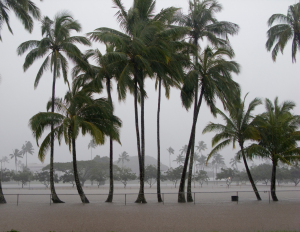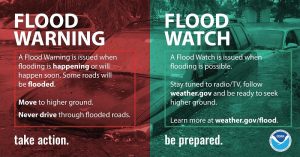What is a Flood?
 Flooding events in Hawaii can be caused by a variety of weather events including rainstorms, tsunamis, hurricanes, and high surf. Depending on the cause these can happen in low laying areas prone to flooding, along streams and coastline, or in areas that have previously not experienced major flooding. Hawaii averages about 11 flood events per year. These mostly happen during wet season (October to May) but are possible at any time.
Flooding events in Hawaii can be caused by a variety of weather events including rainstorms, tsunamis, hurricanes, and high surf. Depending on the cause these can happen in low laying areas prone to flooding, along streams and coastline, or in areas that have previously not experienced major flooding. Hawaii averages about 11 flood events per year. These mostly happen during wet season (October to May) but are possible at any time.
Crossing flood waters, even if they appear shallow, can be extremely dangerous. Most flood related deaths occur when people drive or walk through flooded areas. Between 1915 and 2019, floods have claimed more than 140 lives on Oahu. Of all weather-related disasters in the United States, flash flood are the leading cause of death.
- Urban areas: Flash flooding can happen quickly in urban areas when many surfaces are paved and impermeable.
- Valleys: Flash floods in valleys may appear suddenly as a large volume of rapidly moving water carrying rocks, mud, and other debris. They can occur even in dry areas if there is heavy rainfall upstream.
- Streams: Streams that ordinarily have low flow can increase dramatically when heavy rain is falling upstream.
- Heavy rainfall, especially over Oahu’s higher elevations, can cause downstream flash flooding.
- Dam failures, mudslides, or debris flows can also cause flash floods when they divert water flow suddenly.
Learn more about flooding by hovering over the boxes below:
Flood
Flood
Flash Flood
Flash Flood
 When flooding is possible or occurs, the National Weather Service (NWS) issues alerts to let the public know the seriousness of the threat.
When flooding is possible or occurs, the National Weather Service (NWS) issues alerts to let the public know the seriousness of the threat.
If a flash flood event requires immediate life-saving action, a Wireless Emergency Alert (WEA) will be sent to all mobile devices in the affected area. You do not need to sign up for WEA messages but must ensure they are enabled on your smartphone. Information will also be broadcasted via the Emergency Alert System (EAS) on the TV and radio.
A Flood Advisory is issued when flooding is not expected to bad enough to issue a warning. However, it could cause significant inconvenience, and if caution is not exercised, it could lead to situations that could threaten life and property.
A Flood Watch is issued when flooding is possible. Stay tuned to radio/TV for information and be ready to seek higher ground.
A Flood Warning is issued when flooding is happening or will happen soon. Some roads will be flooded. Move to higher ground. Never drive through flooded roads.
Am I at risk where I live?
Your home or business may be subject to flooding from even light rainfall, high tides, upstream debris or development, high surf, storms, hurricanes, tsunamis, dam or levee failure, sea level rise, coastal erosion, or some combination of these hazards. Be aware of streams, drainage channels, roads, ditches, and other areas known to flood around your home or business. Low risk does not mean no risk.
How do I stay safe?
There are a few things you need to do in order to be prepared for and stay safe during a flooding event. Take whatever actions you can now to be ready when a flood happens.
Before a Flood
Taking action today, before a flood happens, will help ensure you have all the plans and supplies you need. Don’t wait to prepare until a storm is coming as there may be shortages of critical supplies.
Every family is unique and so is every family’s emergency plan. Think about what special people, pets, or circumstances you should plan for. Do you have keiki or kupuna who might need extra help in an emergency? Do you have a pet that you need to pack food or a crate for? What about your power requirements? Do you need electricity for medical devices? Identify the needs and make a plan for each member of the family ahead of time so you can be confident you can take care of your family in an emergency.
Every emergency plan should include some essential things:
- Know if you will have to evacuate your home.
- A location where your family plans to meet if you need to evacuate or are separated.
- Contact information for family members, friends, workplaces, medical providers, and other important contacts. Establish an off-island or out-of-state contact that everyone in your family knows to contact in the event on-island communications are limited.
Learn more at honolulu.gov/dem/preparedness/make-plan.
Some disasters or emergencies like flash floods and tsunamis require quick evacuation. This can occur with little warning, and there may not be enough time to take your entire family disaster supply kit with you.
A Go Bag should provide enough quick-access supplies to get you through the initial phases of an emergency and evacuation. You should have one bag for each member of your household.
Find out what to include in your Evacuation Go Bag at honolulu.gov/dem/build-a-kit.
Your home or business may be subject to flooding from even light rainfall, high tides, upstream debris or development, high surf, storms, hurricanes, tsunamis, dam failure, sea level rise, coastal erosion, or some combination of these hazards. Be aware of streams, drainage channels, roads, ditches, and other areas known to flood around your home or business.
Check your insurance policies to determine what, if any, hurricane-related damage is covered by your policy. Standard homeowner and renters’ insurance do not include hurricane or flood coverage. Purchase or renew a flood insurance policy to protect the life you’ve built.
Check the NOAA National Weather Service Honolulu weather forecast here at https://www.weather.gov/hfo/ for weather and flood alerts before hiking or outdoor activities. Hikers on Oahu have required rescues and have died from flash floods and landslides.
Consider more permanent measures to protect your home, such as wet/dry floodproofing and rain gardens. Store valuables in higher places. Declutter drains and gutters. Consider purchasing sandbags and sand or other easily deployable temporary flood barriers.
When a Flood is a Threat
Once we know there is the threat of flooding, it is time to begin preparing your home and family for potential impacts.
- Prepare home protection measures if you plan to use them. If possible, get sandbags or other barriers ready before flooding starts.
- Take inventory of your both inside and outside of your home and property by taking pictures or videos; save multiple copies and store in a safe place.
- Monitor local radio and TV stations for emergency information and important updates.
- Review your family emergency plan with all members of your household.
- Check the contents of your Evacuation Go Bag.
- Prepare to evacuate in case you need to. Take your supply kit with you wherever you evacuate.
- Have mobile cell phones charged and have an external charger for each
- Backup important electronic files onto an external drive or to the cloud regularly. Keep essential physical documents in a waterproof container.
- Monitor local radio and TV stations for emergency information and important updates.
- Call 911 immediately if there is an emergency.
- Move to higher floors if trapped in a building. Go on the roof if necessary. Once there, signal for help.
- Be aware of the risk of electrocution. Do not touch equipment if it is wet or you are standing in water. If it safe, turn off the electricity to prevent shocks.
- Turn around, don’t drown! Do not attempt to walk, swim, or drive through flowing or rising water.
- Floodwaters can rise rapidly and sweep away a vehicle and its occupants. If your vehicle stalls in a flooded area, get out as soon as possible. However, stay inside your car if you are trapped in rapidly moving water. If water is rising inside the car, get on the roof.
- Use extreme caution when outdoors. Do not cross streams until the flooding completely subsides. A stream can flood within minutes.
After a Flood
After the flood waters have receded, make sure you are staying safe while you assess damage or begin clean up efforts.
Continuously monitor TV (if working) and radio for instructions. Authorities will announce when it is safe to go outside and/or to return to your home.
- Be aware of hazards, i.e. down power lines, broken gas lines, contaminated water, weakened structures, broken glass, etc. Debris on roadways will limit your ability to drive around.
- Avoid wading in floodwater, which may be hiding debris, contaminated with sewage, or electrically charged.
- Be aware of hidden structural damage. Floodwater may have weakened roads and building foundations.
- Be aware of brown water advisories. The Department of Health issues brown water advisories to remind the public to avoid dirty water as it may be contaminated. Periods of heavy rain lead to increased runoff into pools of water and the ocean.
- Prevent carbon monoxide (CO) poisoning. Use generators, pressure washers, or other gasoline-powered machinery outdoors at least 20 feet from doors, windows, or vents.
Photograph flood damage for insurance purposes before cleaning up. Begin to clean up immediately after taking photos, do not wait for a flood insurance adjuster or FEMA home inspector to come to your home.
- Wear heavy boots, gloves, and goggles during cleanup: Your home may be contaminated by overflowing cesspools, sewers, maintenance holes, pesticides, animal fecal matter, dead animals, pathogens, chemicals, and associated debris.
- Thoroughly dry and clean or dispose of materials exposed to floodwater, including food, furniture, drywall, carpet, and other floorings. Porous, absorbent materials that cannot be thoroughly cleaned and dried within 24-48 hours should be discarded.
